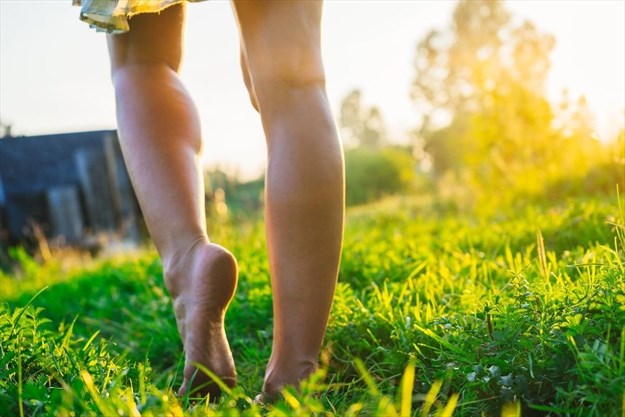Getting Groundedby Carrie Dennett of the Washington Post It is not a secret that spending time in nature is good for you. For years, researchers have been detailing how people who live near green spaces — parks, greenbelts, tree-lined streets, rural landscapes — have better physical and mental health, and practices such as Japanese forest bathing and Nordic hygge, which has a strong outdoorsy component, are being embraced here in the United States. Could grounding be next? I was intrigued when a colleague recently recommended a mutual patient — seeing her for stress management and me for nutritional advice — experiment with walking barefoot in the grass for a short time each day. A few weeks later, I stumbled across an article that gave a name to that practice: grounding. The idea behind grounding, also called earthing, is that humans evolved in direct contact with the Earth's subtle electric charge, but have lost that sustained connection thanks to inventions such as buildings, furniture and shoes with insulated synthetic soles. Advocates of grounding say this disconnect might be contributing to the
chronic diseases that are particularly prevalent in industrialized societies. There is actually some science behind this. Research has shown barefoot contact with the ground can produce nearly instant changes in a variety of physiological measures, helping improve sleep, reduce pain, decrease muscle tension and lower stress. There are many reasons connecting with nature is good for mind and body, but electricity probably is not one you have considered. If you think back to the last time you took a science class, you may remember that everything, including humans, is made up of atoms. These microscopic particles contain equal numbers of negatively-charged electrons, which come in pairs, and positively-charged protons, so an atom is neutral — unless it loses an electron. When an atom has an unpaired electron, it becomes a "free radical" with a positive charge, capable of damaging our cells and contributing to chronic inflammation, cancer and other diseases. In this case, "positive" is not a good thing. One reason direct physical contact with the ground might have beneficial physiological effects is the earth's surface has a negative charge and is constantly generating electrons that could neutralize free radicals, acting as antioxidants. You may think of antioxidants as coming from food, and indeed a diet rich in fruits, vegetables and other foods that provide beta-carotene, selenium, lutein, lycopene and vitamins A, C and E help prevent cellular damage from free radicals. Still, it is interesting that we may be able to get them directly from the earth, too. Research also suggests physical contact with the Earth's surface can help regulate our autonomic nervous system and keep our circadian rhythms -- which regulate body temperature, hormone secretion, digestion and blood pressure, among other things — synchronized with the day/night cycle. Desynchronization of our internal clocks has been linked to a number of health problems, as evidenced by research on shift workers. The key may be the impact on the vagus nerve. This is the largest nerve of the autonomic nervous system — extending from the brain to the colon — and plays a key role in heart, lung and digestive function. Strong vagal tone helps you relax faster after experiencing stress, while weak vagal tone is associated with chronic inflammation. Inflammation, in turn, is associated with a number of chronic diseases — including cardiovascular disease, Type 2 diabetes and some forms of cancer. Vagal tone is often assessed by measuring the variation in your heart rate when you breathe in and out, and in one study, grounding was shown to improve heart rate variability and thus vagal tone in pre-term infants. In another small study of adults, one two-hour session of grounding reduced inflammation and improved blood flow. While many clinical studies have demonstrated beneficial physical changes when participants are grounded, studies tend to be small and are done indoors using wires that connect to ground outlets. This is partly because using a lab is more practical than taking study participants outdoors, but also so participants will not know if they are grounded or not — to avoid a placebo effect. There is little research specifically on the effects of grounding in nature and whether it results in the same positive effects on stress, pain and sleep. Still, since being outdoors is proved to be good for you, it probably would not hurt to try it yourself to see if you notice any benefits. So how do you ground? Simply allow your skin to be in contact with any natural conductors of the earth's electricity, working up to at least 30 minutes at a time (unfortunately, studies do not seem to have addressed how often grounding should occur). You can walk barefoot on grass, moist soil, sand, gravel or concrete (but not other types of pavement). You can swim in the ocean, a lake or other natural body of water. You can sit under a tree, leaning against the trunk. If you have concerns about whether it is sanitary to walk barefoot outside, there are options. Keep a patch of lawn off-limits to your dog. Or put a blanket or towel between your skin and the ground; natural fibres such as cotton and wool do not interfere with grounding. You can even wear leathersoled shoes. Or, garden instead. Digging gloveless in the garden also puts you in direct contact with the earth — just make sure you are not using chemical pesticides or fertilizers. Comments are closed.
|
Welcome to our BlogCategories
All
Archives
April 2020
|
|
Advanced Orthodynamics
235 Locke Street South, Suite 1 Hamilton, ON L8P 4B8 905-527-1225 1-800-400-9203 [email protected] Ontario Assistive Devices Program Vendor |
|
Advanced Orthodynamics is a proud member of
Copyright @ 2024 advancedortho.ca


 RSS Feed
RSS Feed


